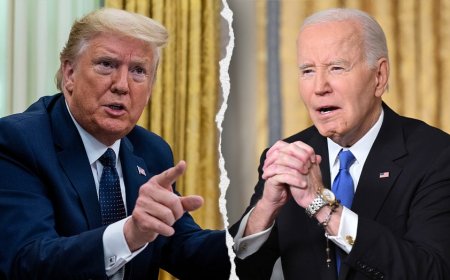The Second Trump Administration Takes Aim at the Climate
The LedeMore than thirty actions and executive orders either boost fossil-fuel production or cripple programs that might reduce fossil-fuel use.By Elizabeth KolbertFebruary 11, 2025Photograph by Eli Hartman / Odessa American / APWhen Donald Trump was inaugurated for the first time, in January, 2017, Columbia University’s Sabin Center for Climate Change Law launched the Climate Deregulation Tracker. Four years and a hundred and seventy-six entries later, when Joe Biden took office, the tool was renamed the Climate Reregulation Tracker.Last month, the tool was renamed again: it’s now the Climate Backtracker. In each of the tool’s three iterations, “our expectations are being fulfilled,” Michael Gerrard, a Columbia Law School professor and the Sabin Center’s faculty director, observed the other day. Since Trump was inaugurated (again), his Administration has taken thirty-three climate-backtracking actions. Most of these have been in the form of executive orders, and most of these E.O.s have been aimed at either boosting fossil-fuel production or crippling programs that might reduce fossil-fuel use. “They’re doing everything possible to increase both the demand for and the supply of fossil fuels,” Gerrard said. “That’s the theme that runs throughout.”The LedeReporting and commentary on what you need to know today.Like New Year’s resolutions, E.O.s are largely aspirational; carrying them out usually requires federal agencies to publish new rules, a painstaking and time-consuming process. In Trump’s first term, new environmental rules were often sloppily drafted, and when they were challenged in court, as they invariably were, the Administration frequently lost. It is too early to know whether the second Trump Administration will be any more careful or any more successful with the judiciary. But experts say that what seems to distinguish the second Trump Presidency when it comes to climate change—or, really, any policy issue—is its willingness to flout administrative law.“This is a very different and more dangerous Administration than the first time around,” Rachel Cleetus, the policy director for the Union of Concerned Scientists’ Climate and Energy program, said. Eight years ago, Cleetus continued, “when we saw the executive orders around funding freezes for a range of climate and energy priorities, the assumption was that we would still have the law obeyed, with Congress having the power of the purse. But in the last three weeks we’ve seen that shredded.”Consider the case of the Inflation Reduction Act, the major piece of climate legislation approved during Biden’s term. The Biden Administration, in its final months, rushed to commit funds appropriated under the act, but, according to an analysis by the Washington Post, of the fifty billion dollars’ worth of grants the Administration awarded, only eighteen billion dollars have actually been paid out. Trump, on his first day back in office, issued an E.O. titled “Unleashing American Energy” that, among its numerous provisions, directed federal agencies to “pause” I.R.A. spending. This was soon followed by a directive from the Office of Management and Budget which instructed all federal agencies to freeze disbursements until they could determine which ones were “implicated by any of the President’s executive orders.”The O.M.B. directive, which could have affected trillions of dollars in federal grants and loans, was immediately—and successfully—challenged in court by a coalition of nonprofit and small-business groups. O.M.B. rescinded the memo, but, that same day, Trump’s press secretary, Karoline Leavitt, insisted in a social-media post that “the President’s EO’s on federal funding remain in full force and effect, and will be rigorously implemented.” By this point, the attorneys general of twenty-two states and the District of Columbia had also sued the Administration. On January 31st, Judge John J. McConnell, Jr., of the U.S. District Court of Rhode Island, directed the Trump Administration to, basically, unfreeze the freeze. But the Administration has, it appears, only selectively complied with his instructions. In a brief submitted to McConnell on Friday, the blue-state attorneys general pointed to “an ever-changing kaleidoscope of federal financial assistance that has been suspended, deleted, in transit, under review, and more” since McConnell’s order was entered. Funds still being held up, they said, include several kinds of payments authorized by the I.R.A., among them grants to help low-income communities install solar panels and subsidies to help low- and moderate-income households install heat pumps.“Many of the programs for which funds were still frozen,” the latest brief noted, “conspicuously mirror the President’s policy attacks.” On Monday, Judge McConnell issued a new order that insisted the Administration comply with his original order. “Persons who make private determinations of the law . . . generally risk criminal contempt,” it observed. Wheth


More than thirty actions and executive orders either boost fossil-fuel production or cripple programs that might reduce fossil-fuel use.
When Donald Trump was inaugurated for the first time, in January, 2017, Columbia University’s Sabin Center for Climate Change Law launched the Climate Deregulation Tracker. Four years and a hundred and seventy-six entries later, when Joe Biden took office, the tool was renamed the Climate Reregulation Tracker.
Last month, the tool was renamed again: it’s now the Climate Backtracker. In each of the tool’s three iterations, “our expectations are being fulfilled,” Michael Gerrard, a Columbia Law School professor and the Sabin Center’s faculty director, observed the other day. Since Trump was inaugurated (again), his Administration has taken thirty-three climate-backtracking actions. Most of these have been in the form of executive orders, and most of these E.O.s have been aimed at either boosting fossil-fuel production or crippling programs that might reduce fossil-fuel use. “They’re doing everything possible to increase both the demand for and the supply of fossil fuels,” Gerrard said. “That’s the theme that runs throughout.”
Like New Year’s resolutions, E.O.s are largely aspirational; carrying them out usually requires federal agencies to publish new rules, a painstaking and time-consuming process. In Trump’s first term, new environmental rules were often sloppily drafted, and when they were challenged in court, as they invariably were, the Administration frequently lost. It is too early to know whether the second Trump Administration will be any more careful or any more successful with the judiciary. But experts say that what seems to distinguish the second Trump Presidency when it comes to climate change—or, really, any policy issue—is its willingness to flout administrative law.
“This is a very different and more dangerous Administration than the first time around,” Rachel Cleetus, the policy director for the Union of Concerned Scientists’ Climate and Energy program, said. Eight years ago, Cleetus continued, “when we saw the executive orders around funding freezes for a range of climate and energy priorities, the assumption was that we would still have the law obeyed, with Congress having the power of the purse. But in the last three weeks we’ve seen that shredded.”
Consider the case of the Inflation Reduction Act, the major piece of climate legislation approved during Biden’s term. The Biden Administration, in its final months, rushed to commit funds appropriated under the act, but, according to an analysis by the Washington Post, of the fifty billion dollars’ worth of grants the Administration awarded, only eighteen billion dollars have actually been paid out. Trump, on his first day back in office, issued an E.O. titled “Unleashing American Energy” that, among its numerous provisions, directed federal agencies to “pause” I.R.A. spending. This was soon followed by a directive from the Office of Management and Budget which instructed all federal agencies to freeze disbursements until they could determine which ones were “implicated by any of the President’s executive orders.”
The O.M.B. directive, which could have affected trillions of dollars in federal grants and loans, was immediately—and successfully—challenged in court by a coalition of nonprofit and small-business groups. O.M.B. rescinded the memo, but, that same day, Trump’s press secretary, Karoline Leavitt, insisted in a social-media post that “the President’s EO’s on federal funding remain in full force and effect, and will be rigorously implemented.” By this point, the attorneys general of twenty-two states and the District of Columbia had also sued the Administration. On January 31st, Judge John J. McConnell, Jr., of the U.S. District Court of Rhode Island, directed the Trump Administration to, basically, unfreeze the freeze. But the Administration has, it appears, only selectively complied with his instructions. In a brief submitted to McConnell on Friday, the blue-state attorneys general pointed to “an ever-changing kaleidoscope of federal financial assistance that has been suspended, deleted, in transit, under review, and more” since McConnell’s order was entered. Funds still being held up, they said, include several kinds of payments authorized by the I.R.A., among them grants to help low-income communities install solar panels and subsidies to help low- and moderate-income households install heat pumps.
“Many of the programs for which funds were still frozen,” the latest brief noted, “conspicuously mirror the President’s policy attacks.” On Monday, Judge McConnell issued a new order that insisted the Administration comply with his original order. “Persons who make private determinations of the law . . . generally risk criminal contempt,” it observed. Whether this new order will prompt the Administration to release the funds or whether it will precipitate a full-blown constitutional crisis remains to be seen. (The O.M.B.’s Web site now directs visitors to the White House Web site; no one at the office could be reached for comment.)
Several of Trump’s backtracking E.O.s are focussed on expediting permits for oil-and-gas drilling on federal lands. According to the orders, environmental regulations could be suspended or revoked if they interfere with this goal, moves which, in turn, could dramatically—and negatively—affect endangered species, air quality, and water supplies. Ostensibly, the intent of these orders is to bring down energy prices, but it seems doubtful that they’ll actually accomplish this, since fossil-fuel prices are already low enough to discourage companies from doing much more drilling. The U.S., meanwhile, is already the world’s largest oil producer and, by a wide margin, the largest producer of natural gas. “I don’t think today that production in the U.S. is constrained,” Darren Woods, the C.E.O. of ExxonMobil, told Semafor a few months ago. “So I don’t know that there’s an opportunity to unleash a lot of production in the near term.”
Other Trump E.O.s take aim at wind power, which is the largest source of renewable power in the U.S. One would block the federal government from leasing sites for offshore wind development, and would also prevent federal agencies from issuing permits for new onshore wind projects. (Wind projects on private land often require some kind of federal permit.)
Even before the change in Administrations, the wind industry was suffering from high interest rates. (Renewable-energy projects have essentially no fuel costs but significant upfront costs.) Under Trump, many projects are likely to be cancelled. Barbara Kates-Garnick, who served as Massachusetts’s undersecretary of energy and is now a professor at Tufts’s Fletcher School, recently estimated that, out of thirty gigawatts’ worth of offshore wind projects that were in the planning phase in 2024, only a sixth will actually get built over the next several years. “That level of offshore wind is certainly not enough to create a viable manufacturing supply chain, provide lasting jobs or deliver the clean energy that the grid requires,” Kates-Garnick wrote.
Still other climate backtracks target electric vehicles. The Administration is holding up five billion dollars that were supposed to go toward building charging stations along the nation’s highways. It is planning to rip up a set of Biden-era fuel-efficiency standards designed to steer automakers toward producing more E.V.s. And it has signalled that it will, once again, go after what’s known as the California waiver, which allows the state to establish stricter air-pollution standards than the federal government’s. (California’s policies have traditionally had a huge impact on the auto industry, both because the state is a big car market and because other states often adopt them.) Recently, S. & P. lowered its forecast of E.V. sales in the U.S. over the next five years by one and a half million vehicles.
All this is happening, of course, as climate change continues apace. Globally, 2024 was the warmest year on record—more than two and half degrees hotter than the preindustrial average. In the U.S., there were twenty-seven climate-related disasters that caused more than a billion dollars’ worth of damage, just one short of the record, set in 2023. Scientists had expected temperatures to moderate this year, because a new, typically cooler weather pattern, known as La Niña, took hold in December. But January, once again, broke all heat records. Bill McGuire, a professor emeritus of geophysical and climate hazards at University College London, called the January data “astonishing and, frankly, terrifying.”
“What the Trump Administration is trying to do is say that climate change doesn’t exist,” Rachel Cleetus, of the Union of Concerned Scientists, said. “Meanwhile, we’re watching a world in which climate events are getting steadily more dangerous and more costly.” ♦


























































